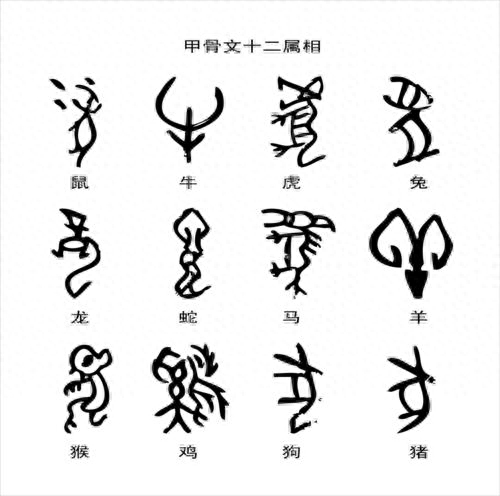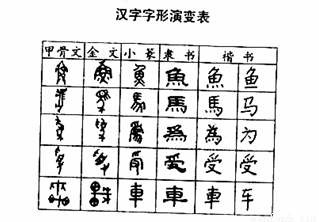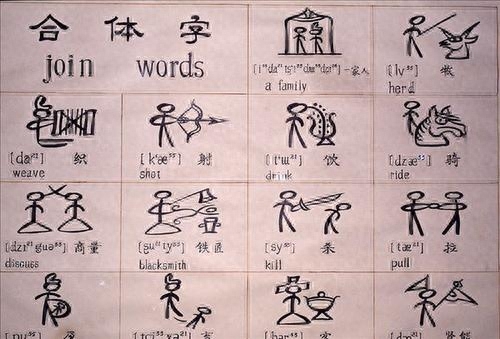Chinese characters have undergone changes for more than 6,000 years, and their evolution process is:
Oracle → Bronze Inscriptions → Small Seal Script → Official Script → Regular Script → Running Script
(Shang) (Zhou) (Qin) (Han) (Wei and Jin) Cursive script
The above seven fonts of "Jiajin Seal, Li, Cao Kaixing" are called "Seven Chinese Characters". The rules are from complex to simple. The details are as follows.
There are two views on the development rules of Chinese characters:
The first:
There are also three laws for the development of Chinese characters:
1. There is a tendency to simplify the form of Chinese characters.
As a kind of ideogram, most of the initial shapes of Chinese characters were quite complex. During the thousands of years of use, Chinese characters have experienced a natural evolution process from complex to simple. The ways of simplification are generally as follows: changing graphics into symbols; Delete redundant and repeated radicals; use fonts with simple strokes to replace fonts with complex strokes; intercept part of the original character to replace the original character, etc. Chinese character glyphs have roughly gone through several forms: oracle bone inscriptions - bronze inscriptions - small seal script - official script - Wei stele - regular script , there are also two auxiliary fonts: running script and cursive script.
2. There is a standardization trend in the shape of Chinese characters.
In the early days, there were no certain rules for the shape of Chinese characters. The positions of the radicals were not fixed, either left or right, or up or down. The phenomenon of homologous characters was also quite serious. Chinese characters were constantly being standardized while being simplified. Standardization was mainly completed by the government, and the most important thing was The first was the "Shu Tongwen" completed by Qin Xiang Li Si. Later, Xu Shen's "Shuowen Jiezi" of the Eastern Han Dynasty, "Xiping Shi Jing" of the Eastern Han Dynasty, Cao Wei's "Zhengshi Shi Jing", and Tang Dynasty's "Kaicheng Shi Jing" Sutra, etc. all played a great role in the standardization of Chinese characters.
3. The shape of Chinese characters has a tendency of phonetic-phonetic transformation.

Chinese characters are a kind of ideographic characters. In oracle bone inscriptions, they are mainly pictographic characters and ideographic characters. The proportion of pictophonetic characters is only 20%. By Xu Shen's "Shuowen Jiezi", the pictophonetic characters accounted for 80%. Today, the pictophonetic characters in Chinese characters are The proportion of Chinese characters is as high as 90%. It can be seen that the development of Chinese characters has a picophonetic process. Because the content expressed by human language is very rich, some are difficult to express pictographically and knowingly. Fortunately, pictographic Chinese characters are Single-type characters are composed of pictographic characters that express new meanings by adding pictographic characters that express meaning by using homophonic phonetic characters. Since pictographic characters can be combined in large numbers from single-body pictographic characters, they can easily express new meanings in the language. , thus solving the problem of insufficient Chinese characters. However, the pictophonetic characters do not destroy the ideographic function of Chinese characters, because there are still half of the symbolic characters. As the saying goes: "A scholar can read half of the characters." This is the brilliance of Chinese characters.

The characteristics and rules of Chinese characters fully reflect the inspiration and wisdom of the ancient Chinese, especially the people of the Central Plains. It also shows that Chinese characters are an ancient and ever-new writing that keeps pace with the times and can adapt to the requirements of modernization.
The second type:
There are four laws for the development of Chinese characters:
1. Linearization of strokes
Strokes: There is a process of formation. In the ancient writing stage from oracle bone inscriptions to seal characters, the strokes gradually formed two types: straight strokes and rounded strokes. After the official transformation, the stroke system of regular script characters with well-proportioned strokes and unified lines was gradually formed.
2. Glyph symbolization

In the history of Chinese characters, there was the "Six Books" theory, which linked the shape and meaning of characters to facilitate the analysis and understanding of the pronunciation and meaning of Chinese characters. This approach treats Chinese characters not as symbols, but as graphic combinations that express meaning. Each component has its origin and rationality. Through analysis, we can find out the ins and outs of the evolution of the glyphs, and thus discover the basis of the meaning.
With the development and evolution of Chinese characters, this rationality was gradually destroyed and lost. The largest evolution of the glyph system was the "official change" from seal script to official script.
The "Li Bian" fundamentally broke the rationality of ancient Chinese characters. Modern Chinese characters, especially simplified modern Chinese characters, have completely broken the weak rationality inherited by regular script, that is, the Chinese character symbol system has been completely symbolized.
3. Structural standardization
After a long period of development and evolution, Chinese characters have gradually changed from irregular to neat and standardized, consistent in size and beautiful in shape.
This specification was formed in the long-term historical practice since the invention of printing. After liberation, the old Song style was changed through the arrangement of glyphs, and the structural system of modern Chinese characters was determined. The Chinese character dot matrix font technology for Chinese information processing and the corresponding national standards The formulation and implementation, through the promotion of computer laser phototypesetting technology, have spread the standardized structure of Chinese characters to thousands of households and all over the world.
4. Character set standardization
Standardization is a new feature brought to Chinese characters by the information revolution. Due to the application and development of computer Chinese information processing technology, the standardization of all aspects of "form, pronunciation, meaning, and use" of Chinese characters has been promoted. The most important one is the standardization of character sets.
The more important one is "Chinese Character Coded Character Set for Information Processing and Exchange·Basic Set". Related ones include "Common Chinese Character List for Modern Chinese", "Common Chinese Character List for Modern Chinese", "Common Chinese Character Glyph Form Table for Printing", etc.
Articles are uploaded by users and are for non-commercial browsing only. Posted by: Lomu, please indicate the source: https://www.daogebangong.com/en/articles/detail/cong-han-zi-fa-zhan-shi-de-jiao-du-tan-tan-han-zi-fa-zhan-de-gui-lyu.html

 支付宝扫一扫
支付宝扫一扫 
评论列表(196条)
测试